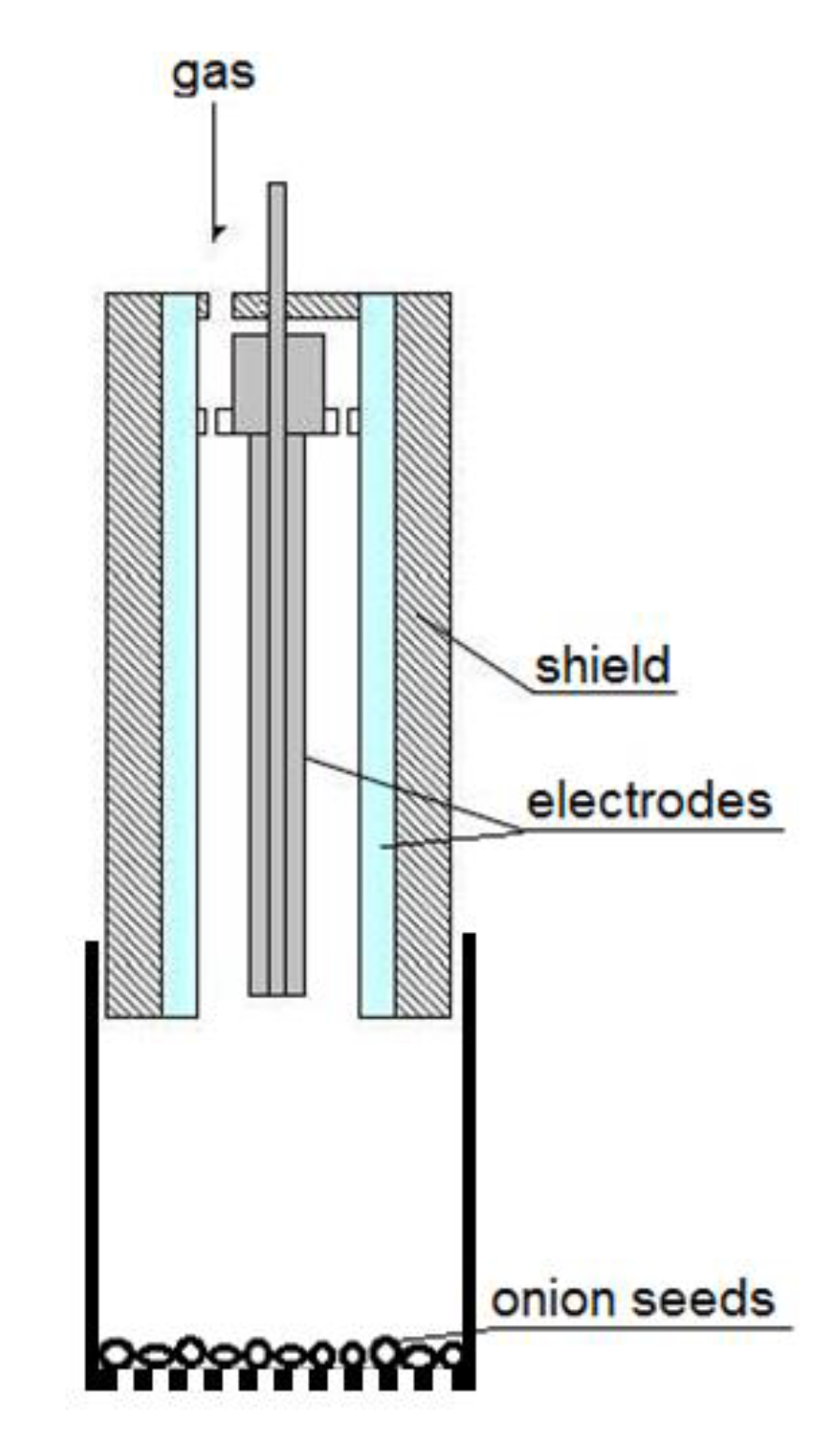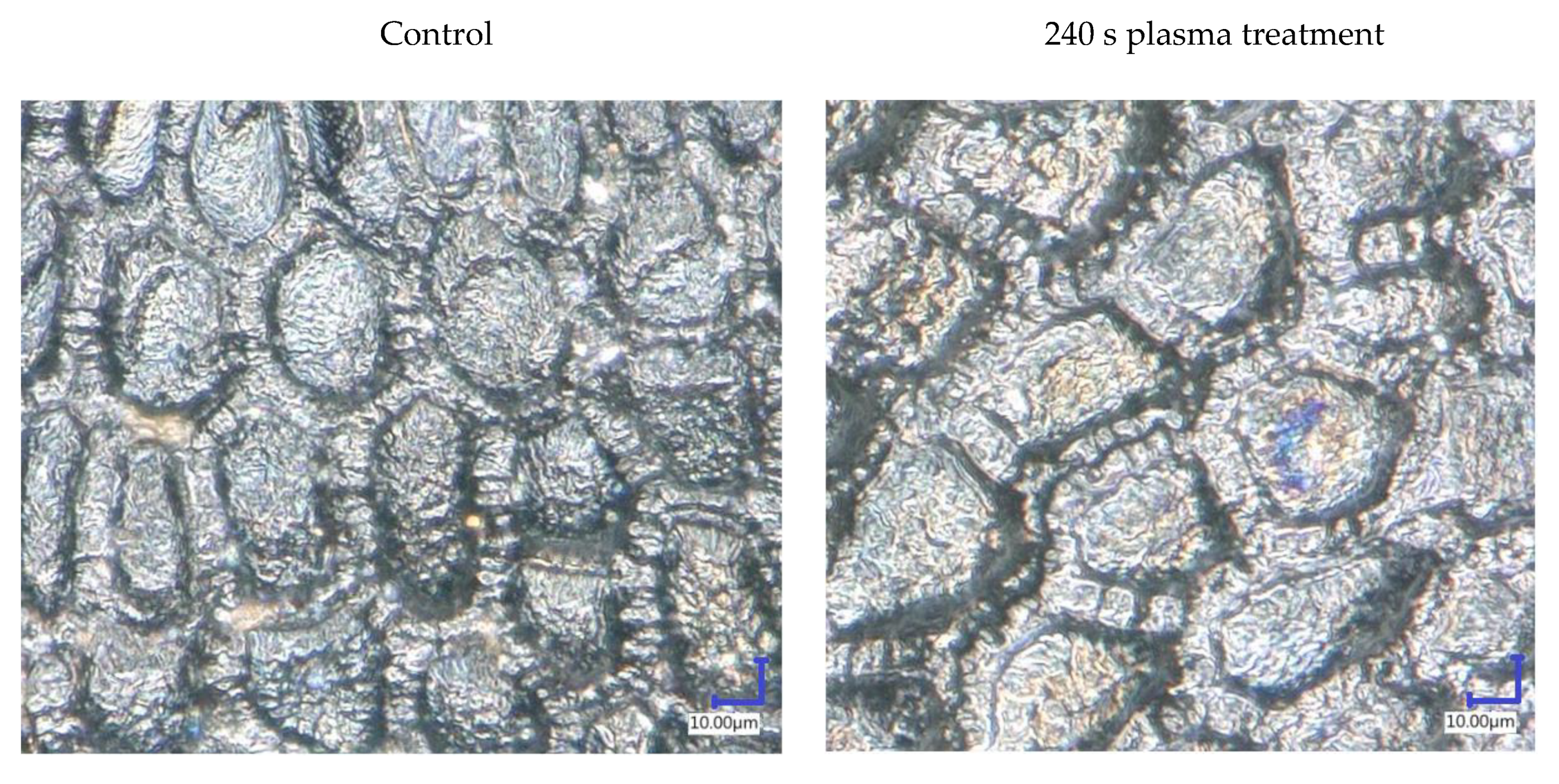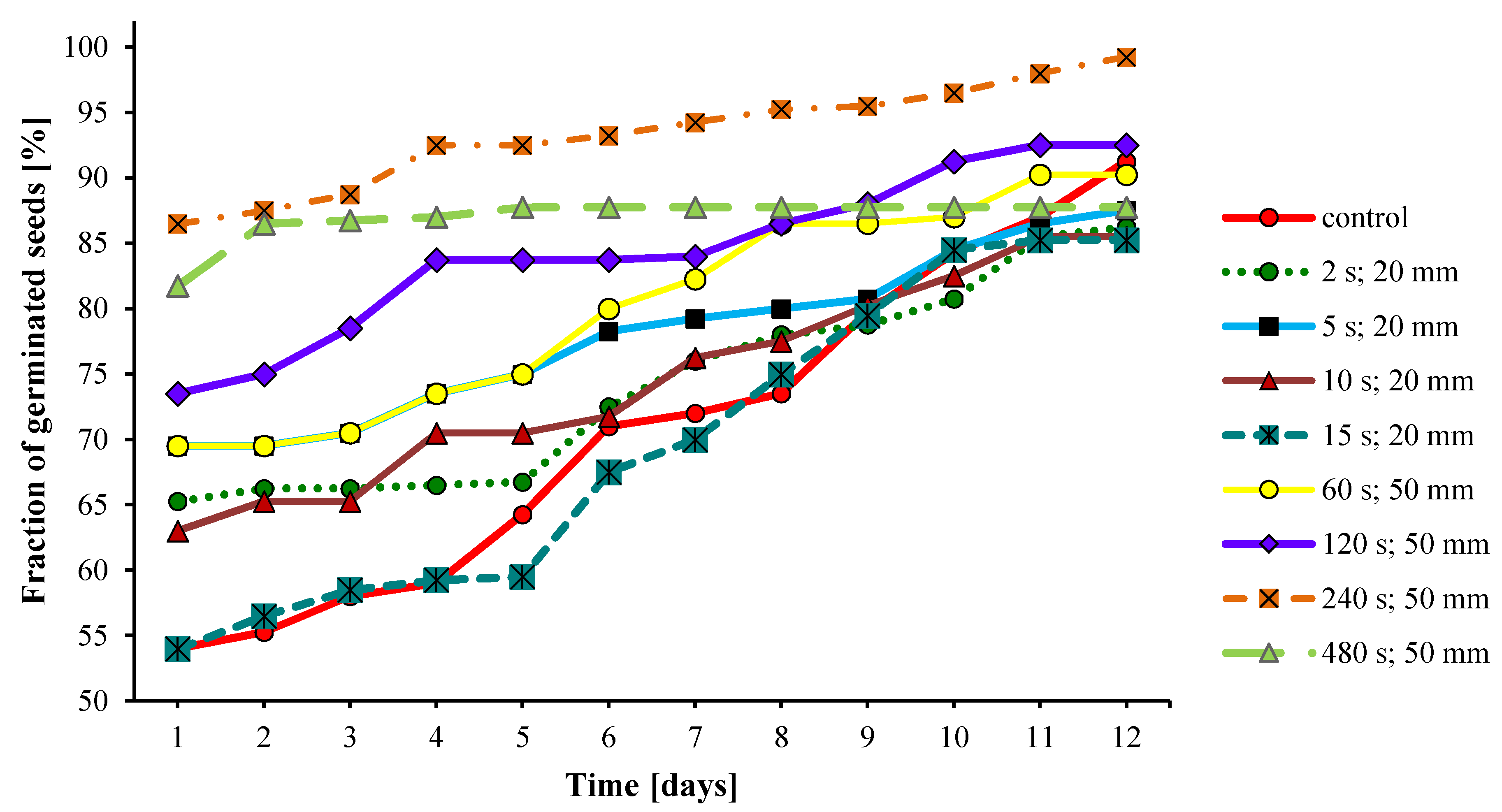Influence of a Helium–Nitrogen RF Plasma Jet on Onion Seed Germination
Abstract
:1. Introduction
2. Materials and Methods
2.1. Cold Plasma Treatment
2.2. Physical and Morphological Properties
2.3. Germination Energy and Capacity
2.4. Statistical Analysis
3. Results and Discussion
4. Conclusions
Author Contributions
Funding
Conflicts of Interest
References
- Pawłat, J.; Starek, A.; Sujak, A.; Terebun, P.; Kwiatkowski, M.; Budzeń, M.; Andrejko, D. Effects of atmospheric pressure plasma jet operating with DBD on Lavatera thuringiaca L. seeds’ germination. PLoS ONE 2018, 13, e0194349. [Google Scholar] [CrossRef] [PubMed] [Green Version]
- Rajjou, L.; Duval, M.; Gallardo, K.; Catusse, J.; Bally, J.; Job, C.; Job, D. Seed Germination and Vigor. Annu. Rev. Plant Biol. 2012, 63, 507–533. [Google Scholar] [CrossRef] [PubMed] [Green Version]
- Delgado-Caballero, M.D.R.; Alarcón-Herrera, M.T.; Valles-Aragón, M.C.; Melgoza-Castillo, A.; Ojeda-Barrios, D.L.; Leyva-Chávez, A. Germination of Bouteloua dactyloides and Cynodon dactylon in a Multi-Polluted Soil. Sustainability 2017, 9, 81. [Google Scholar] [CrossRef] [Green Version]
- Domin, M.; Kluza, F.; Góral, D.; Nazarewicz, S.; Kozłowicz, K.; Szmigielski, M.; Ślaska-Grzywna, B. Germination Energy and Capacity of Maize Seeds Following Low-Temperature Short Storage. Sustainability 2020, 12, 46. [Google Scholar] [CrossRef] [Green Version]
- Khajeh-Hosseini, M.; Powell, A.A.; Bingham, I.J. The interaction between salinity stress and seed vigour during germination of soyabean seeds. Seed Sci. Technol. 2003, 31, 715–725. [Google Scholar] [CrossRef]
- Sujak, A.; Dziwulska-Hunek, A.; Reszczyńska, E. Effect of Electromagnetic Stimulation on Selected Fabaceae Plants. Pol. J. Environ. Stud. 2013, 22, 893–898. [Google Scholar]
- Aladjadjiyan, A. Effect of Microwave Irradiation on Seeds of Lentils (Lens Culinaris, Med.). Rom. J. Biophys. 2010, 20, 213–221. [Google Scholar]
- Dziwulska-Hunek, A.; Sujak, A.; Kornarzyński, K. Short-Term Exposure to Pre-Sowing Electromagnetic Radiation of Amaranth Seeds Affects Germination Energy but not Photosynthetic Pigment Content. Pol. J. Environ. Stud. 2013, 22, 93–98. [Google Scholar]
- Krawiec, M.; Dziwulska-Hunek, A.; Sujak, A.; Palonka, S. Laser irradiation effects on Scorzonera (Scorzonera hispanica L.) seed germination and seedling emergence. Acta Sci. Pol. Hortorum Cultus 2015, 14, 145–158. [Google Scholar]
- Sharma, K.K.; Singh, U.S.; Sharma, P.; Kumar, A.; Sharma, L. Seed treatments for sustainable agriculture-A review. JANS 2015, 7, 521–539. [Google Scholar] [CrossRef]
- Dickenson, A.; Britun, N.; Nikiforov, A.; Leys, C.; Hasan, M.I.; Walsh, J.L. The generation and transport of reactive nitrogen species from a low temperature atmospheric pressure air plasma source. Phys. Chem. Chem. Phys. 2018, 20, 28499–28510. [Google Scholar] [CrossRef] [PubMed]
- Hasan, M.I.; Walsh, J.L. Influence of gas flow velocity on the transport of chemical species in an atmospheric pressure air plasma discharge. Appl. Phys. Lett. 2017, 110, 134102. [Google Scholar] [CrossRef] [Green Version]
- Pawłat, J.; Kwiatkowski, M.; Terebun, P.; Murakami, T. RF-Powered Atmospheric-Pressure Plasma Jet in Surface Treatment of High-Impact Polystyrene. IEEE Trans. Plasma Sci. 2016, 44, 314–320. [Google Scholar] [CrossRef]
- Verlackt, C.C.W.; Boxem, W.V.; Bogaerts, A. Transport and accumulation of plasma generated species in aqueous solution. Phys. Chem. Chem. Phys. 2018, 20, 6845–6859. [Google Scholar] [CrossRef] [PubMed]
- Bogaerts, A.; Yusupov, M.; Razzokov, J.; Van der Paal, J. Plasma for cancer treatment: How can RONS penetrate through the cell membrane? Answers from computer modeling. Front. Chem. Sci. Eng. 2019, 13, 253–263. [Google Scholar] [CrossRef]
- Cordeiro, R.M. Molecular dynamics simulations of the transport of reactive oxygen species by mammalian and plant aquaporins. Biochim. Biophys. Acta (BBA) Gen. Subj. 2015, 1850, 1786–1794. [Google Scholar] [CrossRef]
- Ling, L.; Jiafeng, J.; Jiangang, L.; Minchong, S.; Xin, H.; Hanliang, S.; Yuanhua, D. Effects of cold plasma treatment on seed germination and seedling growth of soybean. Sci. Rep. 2014, 4, 5859. [Google Scholar] [CrossRef] [Green Version]
- Măgureanu, M.; Sîrbu, R.; Dobrin, D.; Gîdea, M. Stimulation of the Germination and Early Growth of Tomato Seeds by Non-thermal Plasma. Plasma Chem. Plasma Process. 2018, 38, 989–1001. [Google Scholar] [CrossRef]
- Ohta, T. Chapter 8—Plasma in Agriculture. In Cold Plasma in Food and Agriculture; Misra, N.N., Schlüter, O., Cullen, P.J., Eds.; Academic Press: San Diego, CA, USA, 2016; pp. 205–221. ISBN 978-0-12-801365-6. [Google Scholar]
- Pawłat, J.; Starek, A.; Sujak, A.; Kwiatkowski, M.; Terebun, P.; Budzeń, M. Effects of atmospheric pressure plasma generated in GlidArc reactor on Lavatera thuringiaca L. seeds’ germination. Plasma Process. Polym. 2018, 15, 1700064. [Google Scholar] [CrossRef]
- Sivachandiran, L.; Khacef, A. Enhanced seed germination and plant growth by atmospheric pressure cold air plasma: Combined effect of seed and water treatment. RSC Adv. 2017, 7, 1822–1832. [Google Scholar] [CrossRef] [Green Version]
- Kopacki, M.; Pawłat, J.; Terebun, P.; Kwiatkowski, M.; Starek, A.; Kiczorowski, P. Efficacy of non-thermal plasma fumigation to control fungi occurring on onion seeds. In Proceedings of the 2017 International Conference on Electromagnetic Devices and Processes in Environment Protection with Seminar Applications of Superconductors (ELMECO AoS), Nałęczów, Poland, 3–6 December 2017; pp. 1–4. [Google Scholar]
- Olalla, F.M.d.S.; Domínguez-Padilla, A.; López, R. Production and quality of the onion crop (Allium cepa L.) cultivated under controlled deficit irrigation conditions in a semi-arid climate. Agric. Water Manag. 2004, 68, 77–89. [Google Scholar] [CrossRef]
- Khan, M.A.; Hasan, M.K.; Miah, M.A.J.; Alam, M.M.; Masum, A. Effect of plant spacing on the growth and yield of different varieties of onion. Pak. J. Biol. Sci. 2003, 6, 1582–1585. [Google Scholar] [CrossRef]
- Kumar, S.; Imtiyaz, M.; Kumar, A. Effect of differential soil moisture and nutrient regimes on postharvest attributes of onion (Allium cepa L.). Sci. Hortic. 2007, 112, 121–129. [Google Scholar] [CrossRef]
- Shigyo, M.; Kik, C. Onion. In Vegetables II: Fabaceae, Liliaceae, Solanaceae, and Umbelliferae; Prohens-Tomás, J., Nuez, F., Eds.; Handbook of Plant Breeding, Vegetables; Springer: New York, NY, USA, 2008; pp. 121–159. ISBN 978-0-387-74108-6. [Google Scholar]
- Pawłat, J.; Terebun, P.; Kwiatkowski, M.; Kiczorowski, P.; Starek, A.; Andrejko, D.; Kopacki, M. Effects of helium-air Rf plasma jet on onion seedling growth. In Proceedings of the 2017 International Conference on Electromagnetic Devices and Processes in Environment Protection with Seminar Applications of Superconductors (ELMECO AoS), Nałęczów, Poland, 3–6 December 2017; pp. 1–4. [Google Scholar]
- Pawłat, J.; Terebun, P.; Kwiatkowski, M.; Starek, A.; Kiczorowski, P.; Andrejko, D.; Kopacki, M. Effects of Helium-Air RF plasma jet on onion seeds’ germination. In Proceedings of the 2017 International Conference on Electromagnetic Devices and Processes in Environment Protection with Seminar Applications of Superconductors (ELMECO AoS), Nałęczów, Poland, 3–6 December 2017; pp. 1–4. [Google Scholar]
- International Seed Testing Association. International Rules for Seed Testing; International Seed Testing Association: Bassersdorf, Switzerland, 2017. [Google Scholar]
- Zhou, Z.; Huang, Y.; Yang, S.; Chen, W. Introduction of a new atmospheric pressure plasma device and application on tomato seeds. Agric. Sci. 2011, 2, 23. [Google Scholar] [CrossRef] [Green Version]
- Jiafeng, J.; Xin, H.; Ling, L.; Jiangang, L.; Hanliang, S.; Qilai, X.; Renhong, Y.; Yuanhua, D. Effect of Cold Plasma Treatment on Seed Germination and Growth of Wheat. Plasma Sci. Technol. 2014, 16, 54. [Google Scholar] [CrossRef] [Green Version]
- Šerá, B.; Špatenka, P.; Šerý, M.; Vrchotová, N.; Hrušková, I. Influence of plasma treatment on wheat and oat germination and early growth. IEEE Trans. Plasma Sci. 2010, 38, 2963–2968. [Google Scholar] [CrossRef]
- Kakati, B.; Bujarbarua, S.; Bora, D. An eco-friendly, pollution-free process for seed germination and plant yield. AIP Conf. Proc. 2019, 2091, 020021. [Google Scholar] [CrossRef]
- Zahoranová, A.; Hoppanová, L.; Šimončicová, J.; Tučeková, Z.; Medvecká, V.; Hudecová, D.; Kaliňáková, B.; Kováčik, D.; Černák, M. Effect of Cold Atmospheric Pressure Plasma on Maize Seeds: Enhancement of Seedlings Growth and Surface Microorganisms Inactivation. Plasma Chem. Plasma Process. 2018, 38, 969–988. [Google Scholar] [CrossRef]



| Time of Stimulation [s]; Distance between Nozzle’s Outlet and Tested Material [mm] | Maximum Seed Temperature after Cold Plasma Stimulation [°C] | Moisture Content [%] | Compressive Force [N] |
|---|---|---|---|
| Control—25.8 | Control—9.18 ± 0.05 abc | Control—33.46 ± 1.07 ac | |
| 2; 20 | 27.5 | 9.09 ± 0.03 abc | 34.34 ± 1.06 ab |
| 5; 20 | 29.3 | 9.11 ± 0.16 abc | 33.72 ± 0.66 abc |
| 10; 20 | 33.7 | 8.92 ± 0.28 ac | 34.02 ± 1.55 abc |
| 15; 20 | 35.2 | 8.83 ± 0.06 c | 37.09 ± 1.64 b |
| 60; 50 | 47.2 | 9.15 ± 0.09 abc | 34.07 ± 0.76 ab |
| 120; 50 | 52.6 | 9.23 ± 0.04 ab | 31.69 ± 1.55 ac |
| 240; 50 | 54.0 | 9.22 ± 0.08 ab | 30.20 ± 1.31 cd |
| 480; 50 | 57.2 | 9.45 ± 0.13 b | 27.44 ± 1.12 d |
| Time of Stimulation [s]; Distance between Nozzle’s Outlet and Tested Material [mm] | Germination Energy GEN [%] | Germination Capacity GC [%] |
|---|---|---|
| Control—71.0 ± 0.82 a | Control—91.25 ± 0.96 bc | |
| 2; 20 | 72.5 ± 1.7 a | 86.3 ± 2.6 ab |
| 5; 20 | 78.3 ± 2.2 b | 87.5 ± 2.7 abc |
| 10; 20 | 71.8 ± 2.5 a | 85.5 ± 3.0 a |
| 15; 20 | 67.5 ± 2.1 a | 85.3 ± 3.9 a |
| 60; 50 | 80.0 ± 1.4 bc | 90.3 ± 0.9 abc |
| 120; 50 | 83.8 ± 3.1 cd | 92.5 ± 0.5 c |
| 240; 50 | 93.3 ± 1.8 e | 99.3 ± 0.8 d |
| 480; 50 | 87.8 ± 1.1 d | 87.8 ± 1.1 abc |
Publisher’s Note: MDPI stays neutral with regard to jurisdictional claims in published maps and institutional affiliations. |
© 2020 by the authors. Licensee MDPI, Basel, Switzerland. This article is an open access article distributed under the terms and conditions of the Creative Commons Attribution (CC BY) license (http://creativecommons.org/licenses/by/4.0/).
Share and Cite
Starek-Wójcicka, A.; Sagan, A.; Terebun, P.; Kwiatkowski, M.; Kiczorowski, P.; Pawlat, J. Influence of a Helium–Nitrogen RF Plasma Jet on Onion Seed Germination. Appl. Sci. 2020, 10, 8973. https://doi.org/10.3390/app10248973
Starek-Wójcicka A, Sagan A, Terebun P, Kwiatkowski M, Kiczorowski P, Pawlat J. Influence of a Helium–Nitrogen RF Plasma Jet on Onion Seed Germination. Applied Sciences. 2020; 10(24):8973. https://doi.org/10.3390/app10248973
Chicago/Turabian StyleStarek-Wójcicka, Agnieszka, Agnieszka Sagan, Piotr Terebun, Michał Kwiatkowski, Piotr Kiczorowski, and Joanna Pawlat. 2020. "Influence of a Helium–Nitrogen RF Plasma Jet on Onion Seed Germination" Applied Sciences 10, no. 24: 8973. https://doi.org/10.3390/app10248973
APA StyleStarek-Wójcicka, A., Sagan, A., Terebun, P., Kwiatkowski, M., Kiczorowski, P., & Pawlat, J. (2020). Influence of a Helium–Nitrogen RF Plasma Jet on Onion Seed Germination. Applied Sciences, 10(24), 8973. https://doi.org/10.3390/app10248973






